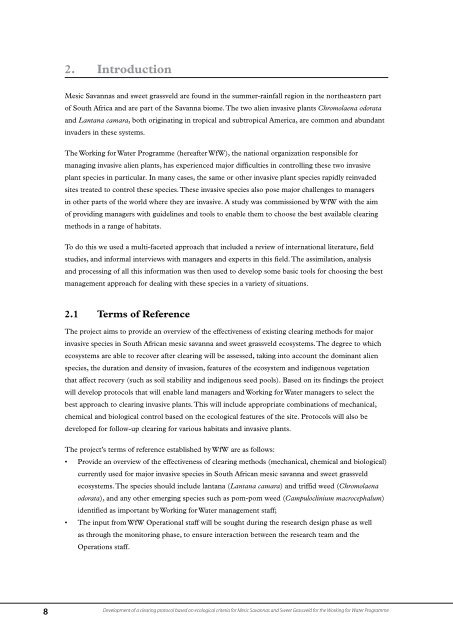Euston-Brown, D., Rathogwa, N & Richardson ... - DWA Home Page
Euston-Brown, D., Rathogwa, N & Richardson ... - DWA Home Page
Euston-Brown, D., Rathogwa, N & Richardson ... - DWA Home Page
You also want an ePaper? Increase the reach of your titles
YUMPU automatically turns print PDFs into web optimized ePapers that Google loves.
2. Introduction<br />
Mesic Savannas and sweet grassveld are found in the summer-rainfall region in the northeastern part<br />
of South Africa and are part of the Savanna biome. The two alien invasive plants Chromolaena odorata<br />
and Lantana camara, both originating in tropical and subtropical America, are common and abundant<br />
invaders in these systems.<br />
The Working for Water Programme (hereafter WfW), the national organization responsible for<br />
managing invasive alien plants, has experienced major difficulties in controlling these two invasive<br />
plant species in particular. In many cases, the same or other invasive plant species rapidly reinvaded<br />
sites treated to control these species. These invasive species also pose major challenges to managers<br />
in other parts of the world where they are invasive. A study was commissioned by WfW with the aim<br />
of providing managers with guidelines and tools to enable them to choose the best available clearing<br />
methods in a range of habitats.<br />
To do this we used a multi-faceted approach that included a review of international literature, field<br />
studies, and informal interviews with managers and experts in this field. The assimilation, analysis<br />
and processing of all this information was then used to develop some basic tools for choosing the best<br />
management approach for dealing with these species in a variety of situations.<br />
2.1 Terms of Reference<br />
The project aims to provide an overview of the effectiveness of existing clearing methods for major<br />
invasive species in South African mesic savanna and sweet grassveld ecosystems. The degree to which<br />
ecosystems are able to recover after clearing will be assessed, taking into account the dominant alien<br />
species, the duration and density of invasion, features of the ecosystem and indigenous vegetation<br />
that affect recovery (such as soil stability and indigenous seed pools). Based on its findings the project<br />
will develop protocols that will enable land managers and Working for Water managers to select the<br />
best approach to clearing invasive plants. This will include appropriate combinations of mechanical,<br />
chemical and biological control based on the ecological features of the site. Protocols will also be<br />
developed for follow-up clearing for various habitats and invasive plants.<br />
The project’s terms of reference established by WfW are as follows:<br />
• Provide an overview of the effectiveness of clearing methods (mechanical, chemical and biological)<br />
currently used for major invasive species in South African mesic savanna and sweet grassveld<br />
ecosystems. The species should include lantana (Lantana camara) and triffid weed (Chromolaena<br />
odorata), and any other emerging species such as pom-pom weed (Campuloclinium macrocephalum)<br />
identified as important by Working for Water management staff;<br />
• The input from WfW Operational staff will be sought during the research design phase as well<br />
as through the monitoring phase, to ensure interaction between the research team and the<br />
Operations staff.<br />
Development of a clearing protocol based on ecological criteria for Mesic Savannas and Sweet Grassveld for the Working for Water Programme
















